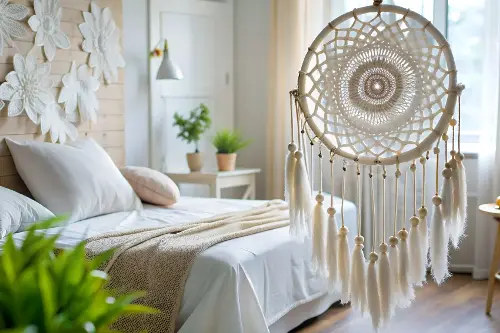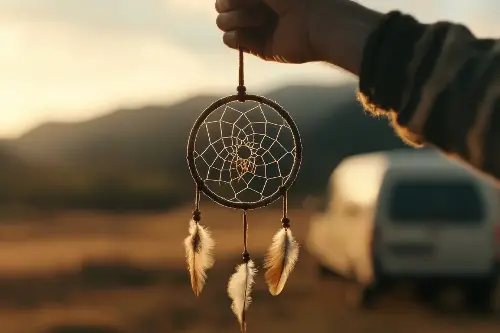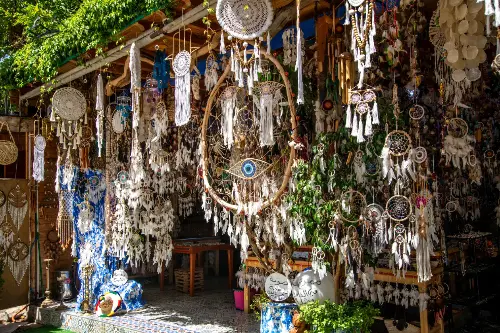Tucked away in the annals of indigenous tradition lies the enigmatic dream catcher, a mystical artefact that fascinates the modern world. Said to snare nightmares in its woven network while allowing peaceful dreams to pass through, the dream catcher serves as more than just a decorative item—it is a symbol of protection and spiritualism deeply rooted in the ancient cultures of the Native American peoples.

Origins amidst the Ojibwe Nation
The story of the dream catcher begins with the Ojibwe Nation, who are indigenous to parts of Canada and the northern United States. The Ojibwe, also known as Chippewa, have an oral history that introduces the dream catcher—or 'asabikeshiinh', meaning 'spider'—as an emblem of protection. This stems from a legend about a mystical being known as Asibikaashi, or Spider Woman, who was a caretaker of the people, especially children.
As the Ojibwe Nation dispersed across the continent, Asibikaashi found it challenging to continue her protective watch over all the members. In response, the mothers and grandmothers began creating dream catchers to mimic the Spider Woman's safeguarding energy. They believed these sacred hoops, with their intricate webs, would filter dreams, catching the bad ones and allowing the good dreams to trickle down the feathers to the sleeper below.
Symbolism in the Craft
Every element of a dream catcher's design holds significance. The circular frame, traditionally made from willow, represents the circle of life, with no beginning or end. The web woven onto the frame, often resembling a spider's web, captures any harm that might be lurking in the dream realm.
The strands that come together at the centre symbolise the travel of the good dreams through the "spider hole" to the sleeping individual. Feathers attached to the dream catcher are another integral part, representing breath or air, which is essential for life. The type of feather also holds importance: owl feathers signify wisdom and are typically used in a female’s dream catcher, whereas eagle feathers, indicative of courage, are used in males’.

Cultural Expansion and Adaptation
As the dream catcher found its way into the cultures of other Native American tribes, each infused it with unique symbology and styles. The Lakota people have their interpretation of the dream catcher's origins, involving a cultural hero named Iktomi who is associated with trickery and wisdom. The story goes that Iktomi spun a web on a willow hoop while speaking to an elder about the cycles of life. The resulting web was a perfect circle with a hole in the centre, representing how we may use good ideas (which enter through the hole) while bad ideas are trapped and rendered ineffective.
Moreover, as dream catchers have become popular across the globe, this cultural symbol has been adopted and adapted by people far from its original indigenous roots. While this speaks to the universal appeal of the dream catcher, it's important to remember the depth of its cultural significance and the respect that should accompany its use and representation.
Modern Significance and Use
Today, dream catchers are found in a myriad of settings, used not only as protective charms but also as a symbol of unity among indigenous peoples and recognition of their artistic heritage. These beautiful objects have evolved into a cross-cultural phenomenon that transcends their traditional purpose.
Dream catchers are often crafted as intricate pieces of art, with different materials such as gemstones, beads, and various feathers incorporated into their design. They adorn bedrooms, ceremonial spaces, and even public venues, promoting an atmosphere of spiritual wellbeing and serving as a testament to the craftsmanship and cultural depth of the original indigenous creators.
In the digital age, the spirit of the dream catcher has also taken on new forms. It's common to see the iconic image emblazoned on clothing, tattoos, digital media, and more—echoing the evolving narrative of this cultural artefact.

Caring for a Dream Catcher
Owning a dream catcher carries the responsibility of honouring its origin. It's more than just an ordinary object; it's a conduit for good energy and positivity. Caring for a dream catcher means placing it respectfully in your living space, ideally where the morning light can touch it. The light is believed to purify or release any trapped nightmares.
In terms of maintenance, dream catchers should be treated delicately, often requiring only minimal, gentle cleaning to prevent dust from accumulating on the feathers and web. This also serves to maintain the integrity of its craftsmanship.
For those who appreciate the cultural history behind dream catchers and wish to integrate one into their lives, it's essential to seek out authentic indigenous artisans. In doing so, you not only acquire a beautiful and meaningful artefact but also support the survival and recognition of indigenous artistry.
The dream catcher is a splendid bridge between the physical and spiritual realms, a reminder of the interconnectedness of life and the ongoing cultural heritage that flourishes within indigenous communities. Its timeless appeal is a testament to the resonant power of symbols and their capacity to engage the human imagination. As it continues to captivate people around the world, the dream catcher's story—rooted in the mystical lore of indigenous cultures—remains an enduring testament to the depth and diversity of human beliefs and artistic expression.
